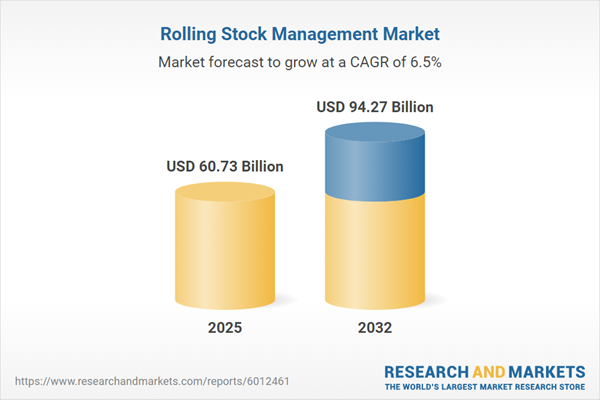Speak directly to the analyst to clarify any post sales queries you may have.
The rolling stock management market is evolving rapidly in response to increasing demands for operational efficiency, sustainability, and technology-driven excellence within global rail networks.
Market Snapshot: Rolling Stock Management Market Growth and Opportunity
The Rolling Stock Management Market grew from USD 57.10 billion in 2024 to USD 60.73 billion in 2025. It is expected to continue growing at a CAGR of 6.46%, reaching USD 94.27 billion by 2032.
As rail operators and manufacturers adapt to shifting regulatory landscapes and customer expectations, their investment priorities are transitioning toward advanced diagnostic, maintenance, and propulsion solutions to strengthen operational resilience, accelerate upgrade cycles, and address environmental targets.Scope & Market Segmentation
This report analyzes the rolling stock management market by key components, emerging technologies, applications, end users, and regions.
- Component Types: Bogies, braking systems (including disc and regenerative brakes), control systems, HVAC, and propulsion systems (diesel, electric, hybrid)
- Technology Platforms: AI analytics, condition monitoring, predictive maintenance, remote diagnostics, telematics
- Application Segments: Freight transport (automobile, bulk, container, refrigerated), passenger transport (high speed rail, intercity, urban transit)
- End Users: Government operators, leasing firms, private operators
- Regional Markets: Americas (United States, Canada, Mexico, Brazil, Argentina, Chile, Colombia, Peru), Europe, Middle East & Africa (including United Kingdom, Germany, France, Russia, Italy, Spain, Netherlands, Sweden, Poland, Switzerland, United Arab Emirates, Saudi Arabia, Qatar, Turkey, Israel, South Africa, Nigeria, Egypt, Kenya), Asia-Pacific (China, India, Japan, Australia, South Korea, Indonesia, Thailand, Malaysia, Singapore, Taiwan)
- Industry Players: Siemens Mobility GmbH, Alstom SA, Wabtec Corporation, Hitachi Rail Ltd., Thales S.A., Knorr-Bremse AG, ABB Ltd., Progress Rail Services Corporation, CRRC Corporation, Stadler Rail AG
Key Takeaways: Strategic Insights for Rolling Stock Management
- Rapid digitalization is driving the adoption of real-time diagnostics and condition-based maintenance, enabling more proactive asset management across diverse rolling stock fleets.
- Sustainability imperatives prioritize energy-efficient solutions, incentivizing the shift toward hybrid and electric propulsion, regenerative braking, and subsystem upgrades.
- Operational improvements now rely on interoperability standards and advanced analytics to coordinate maintenance schedules, optimize inventory, and streamline cross-border operations.
- Resilient supply chains are critical amid global uncertainties, prompting increased dual sourcing, nearshoring, and local production to reduce exposure to trade disruptions.
- Regional market dynamics shape investment priorities: while North America and Europe focus on modernization and electrification, Asia-Pacific pushes ambitious fleet expansions with advanced technology adoption.
- Effective rolling stock strategies integrate modular component designs, predictive analytics, and close alignment between engineering, operations, and data science teams for optimal lifecycle management.
Tariff Impact: United States Trade Policy and Supply Chain Adaptation
Recent U.S. tariffs on critical rolling stock components, such as braking assemblies and specialized propulsion parts, are prompting manufacturers to diversify supply chains and explore alternative sourcing options. Regional partnerships and local component production in key international markets have become essential to maintaining operational continuity and minimizing lead time and quality risks. This evolving trade environment is driving greater agility and risk management within procurement functions.
Methodology & Data Sources
The research integrates primary interviews with senior rail executives, maintenance specialists, and technology providers, combined with secondary analysis of technical reports and regulatory documents. Expert panels validate findings and ensure regional relevance, using benchmarking and comparative frameworks to assess technology maturity, supply chain risks, and end user perspectives.
Why This Report Matters
- Delivers actionable insights for optimizing rolling stock investment strategies, supporting sustainable operations and competitive positioning.
- Empowers decision-makers with a granular view of segmentation, technology trends, and emerging operational models specific to their region.
- Anticipates regulatory and supply chain shifts, helping stakeholders proactively mitigate risks and capture new growth opportunities.
Conclusion
The rolling stock management landscape is evolving through integrated technology, modular components, and regionally adaptive procurement strategies. This report provides senior leaders with essential intelligence to improve performance, embrace sustainability, and navigate future industry complexities.
Additional Product Information:
- Purchase of this report includes 1 year online access with quarterly updates.
- This report can be updated on request. Please contact our Customer Experience team using the Ask a Question widget on our website.
Table of Contents
3. Executive Summary
4. Market Overview
7. Cumulative Impact of Artificial Intelligence 2025
Companies Mentioned
The companies profiled in this Rolling Stock Management market report include:- Siemens Mobility GmbH
- Alstom SA
- Wabtec Corporation
- Hitachi Rail, Ltd.
- Thales S.A.
- Knorr-Bremse AG
- ABB Ltd.
- Progress Rail Services Corporation
- CRRC Corporation
- Stadler Rail AG
Table Information
| Report Attribute | Details |
|---|---|
| No. of Pages | 196 |
| Published | October 2025 |
| Forecast Period | 2025 - 2032 |
| Estimated Market Value ( USD | $ 60.73 Billion |
| Forecasted Market Value ( USD | $ 94.27 Billion |
| Compound Annual Growth Rate | 6.4% |
| Regions Covered | Global |
| No. of Companies Mentioned | 11 |









